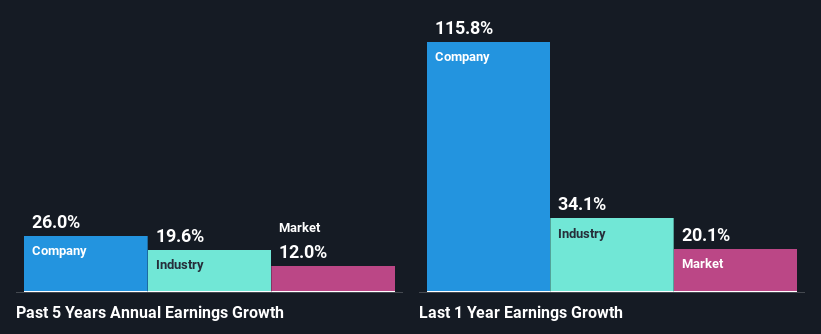Thermo Fisher Scientific Inc.'s (NYSE:TMO) Fundamentals Look Pretty Strong: Could The Market Be Wrong About The Stock?
With its stock down 6.2% over the past month, it is easy to disregard Thermo Fisher Scientific (NYSE:TMO). However, stock prices are usually driven by a company’s financial performance over the long term, which in this case looks quite promising. In this article, we decided to focus on Thermo Fisher Scientific's ROE.
ROE or return on equity is a useful tool to assess how effectively a company can generate returns on the investment it received from its shareholders. Simply put, it is used to assess the profitability of a company in relation to its equity capital.
See our latest analysis for Thermo Fisher Scientific
How Is ROE Calculated?
ROE can be calculated by using the formula:
Return on Equity = Net Profit (from continuing operations) ÷ Shareholders' Equity
So, based on the above formula, the ROE for Thermo Fisher Scientific is:
23% = US$7.9b ÷ US$35b (Based on the trailing twelve months to April 2021).
The 'return' refers to a company's earnings over the last year. That means that for every $1 worth of shareholders' equity, the company generated $0.23 in profit.
What Is The Relationship Between ROE And Earnings Growth?
So far, we've learned that ROE is a measure of a company's profitability. We now need to evaluate how much profit the company reinvests or "retains" for future growth which then gives us an idea about the growth potential of the company. Assuming everything else remains unchanged, the higher the ROE and profit retention, the higher the growth rate of a company compared to companies that don't necessarily bear these characteristics.
A Side By Side comparison of Thermo Fisher Scientific's Earnings Growth And 23% ROE
Firstly, we acknowledge that Thermo Fisher Scientific has a significantly high ROE. Additionally, the company's ROE is higher compared to the industry average of 18% which is quite remarkable. As a result, Thermo Fisher Scientific's exceptional 26% net income growth seen over the past five years, doesn't come as a surprise.
We then compared Thermo Fisher Scientific's net income growth with the industry and we're pleased to see that the company's growth figure is higher when compared with the industry which has a growth rate of 20% in the same period.
Earnings growth is a huge factor in stock valuation. It’s important for an investor to know whether the market has priced in the company's expected earnings growth (or decline). Doing so will help them establish if the stock's future looks promising or ominous. What is TMO worth today? The intrinsic value infographic in our free research report helps visualize whether TMO is currently mispriced by the market.
Is Thermo Fisher Scientific Using Its Retained Earnings Effectively?
Thermo Fisher Scientific's three-year median payout ratio to shareholders is 8.4%, which is quite low. This implies that the company is retaining 92% of its profits. So it seems like the management is reinvesting profits heavily to grow its business and this reflects in its earnings growth number.
Moreover, Thermo Fisher Scientific is determined to keep sharing its profits with shareholders which we infer from its long history of nine years of paying a dividend. Existing analyst estimates suggest that the company's future payout ratio is expected to drop to 5.1% over the next three years. Despite the lower expected payout ratio, the company's ROE is not expected to change by much.
Conclusion
On the whole, we feel that Thermo Fisher Scientific's performance has been quite good. Specifically, we like that the company is reinvesting a huge chunk of its profits at a high rate of return. This of course has caused the company to see substantial growth in its earnings. Having said that, on studying current analyst estimates, we were concerned to see that while the company has grown its earnings in the past, analysts expect its earnings to shrink in the future. To know more about the company's future earnings growth forecasts take a look at this free report on analyst forecasts for the company to find out more.
This article by Simply Wall St is general in nature. It does not constitute a recommendation to buy or sell any stock, and does not take account of your objectives, or your financial situation. We aim to bring you long-term focused analysis driven by fundamental data. Note that our analysis may not factor in the latest price-sensitive company announcements or qualitative material. Simply Wall St has no position in any stocks mentioned.
Have feedback on this article? Concerned about the content? Get in touch with us directly. Alternatively, email editorial-team (at) simplywallst.com.

 Yahoo Finance
Yahoo Finance 
